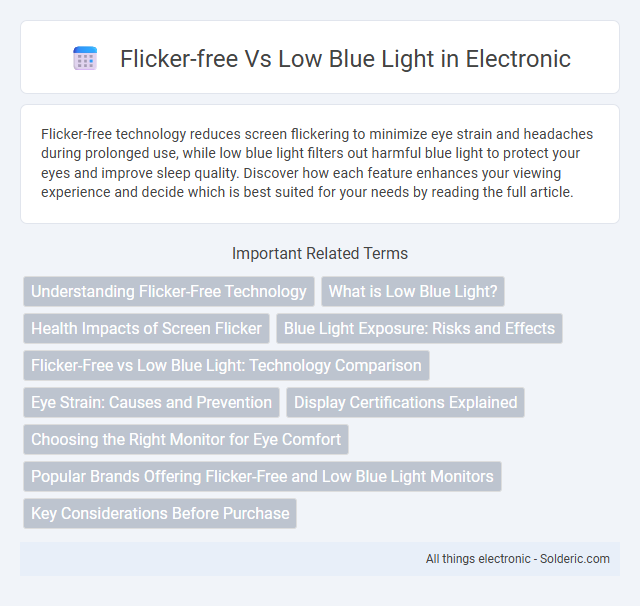Flicker-free technology reduces screen flickering to minimize eye strain and headaches during prolonged use, while low blue light filters out harmful blue light to protect your eyes and improve sleep quality. Discover how each feature enhances your viewing experience and decide which is best suited for your needs by reading the full article.
Comparison Table
| Feature | Flicker-Free | Low Blue Light |
|---|---|---|
| Definition | Technology that eliminates screen flickering for stable viewing. | Filter that reduces harmful blue light emission from screens. |
| Primary Benefit | Reduces eye strain and headaches caused by flickering. | Minimizes risk of digital eye strain and improves sleep quality. |
| Target Audience | Users sensitive to screen flicker and prolonged screen use. | Users exposed to screens long hours, especially at night. |
| Health Impact | Prevents headaches, visual fatigue. | Reduces blue light impact on circadian rhythm and retina. |
| Technology | DC modulation or hardware design to stabilize backlight. | Software or hardware-based blue light filter technologies. |
| Common Usage | Monitors, laptops, smartphones for continuous use comfort. | Monitors, smartphones, and eye protection apps or modes. |
Understanding Flicker-Free Technology
Flicker-free technology reduces screen flickering by providing a steady LED backlight, minimizing eye strain and headaches during prolonged use. Low blue light filters decrease harmful blue light emissions, protecting the retina and improving sleep quality by reducing circadian rhythm disruption. Combining flicker-free displays with low blue light settings enhances overall visual comfort and supports eye health for extended screen time.
What is Low Blue Light?
Low Blue Light technology reduces the emission of high-energy blue wavelengths from screens, which can cause eye strain and disrupt sleep patterns. Unlike Flicker-free screens that minimize screen flickering to prevent headaches and eye fatigue, Low Blue Light specifically targets harmful blue light exposure to protect your eyes during prolonged use. Implementing Low Blue Light features can enhance visual comfort and promote healthier digital device usage.
Health Impacts of Screen Flicker
Screen flicker causes eye strain, headaches, and visual fatigue, negatively impacting your overall eye health and productivity. Flicker-free technology reduces these symptoms by stabilizing the screen's light output, preventing rapid brightness changes that can stress retinal cells. Low blue light filters decrease blue light exposure, but only flicker-free displays directly address the disruptive health effects caused by screen flicker.
Blue Light Exposure: Risks and Effects
Blue light exposure from screens can lead to digital eye strain, causing symptoms like dryness, irritation, and blurred vision. Flicker-free technology reduces screen flickering that contributes to visual fatigue, while low blue light filters specifically decrease the amount of harmful blue wavelengths emitted. Prolonged exposure to blue light is linked to disrupted circadian rhythms and increased risk of retinal damage, highlighting the importance of combining both flicker-free and low blue light features for optimal eye protection.
Flicker-Free vs Low Blue Light: Technology Comparison
Flicker-free technology reduces screen flickering by stabilizing backlight pulses, minimizing eye strain during prolonged use. Low blue light technology filters harmful blue wavelengths emitted by displays to protect retinal cells and improve sleep quality. Both technologies enhance visual comfort, but flicker-free targets screen stability while low blue light addresses spectral emission for eye health.
Eye Strain: Causes and Prevention
Eye strain results from prolonged exposure to screen flicker and excessive blue light, both of which can cause discomfort, headaches, and blurred vision. Flicker-free technology stabilizes screen brightness to reduce rapid light fluctuations, while low blue light filters minimize exposure to high-energy wavelengths that disrupt sleep and cause eye fatigue. Your best defense against eye strain combines flicker-free displays with low blue light settings to maintain visual comfort during extended screen use.
Display Certifications Explained
Display certifications such as TUV Rheinland Flicker-Free and Low Blue Light verify screen quality by reducing eye strain through specific technologies. Flicker-free certification ensures display backlight stability without flickering, minimizing visual fatigue during extended use. Low Blue Light certification filters harmful blue light emissions, protecting Your eyes from potential retinal damage and improving overall screen comfort.
Choosing the Right Monitor for Eye Comfort
Flicker-free monitors reduce screen flickering that can cause eye strain and headaches during extended use, while low blue light displays minimize exposure to harmful blue light wavelengths linked to digital eye fatigue and disrupted sleep patterns. Selecting a monitor with both flicker-free technology and low blue light certification ensures optimal visual comfort and long-term eye health. Prioritize models featuring TUV Rheinland or SGS certification, as these standards validate effective flicker reduction and blue light filtering capabilities.
Popular Brands Offering Flicker-Free and Low Blue Light Monitors
Popular brands offering flicker-free and low blue light monitors include ASUS, Dell, BenQ, and LG, known for integrating advanced eye-care technologies in their displays. ASUS models often feature TUV Rheinland certification for flicker-free and low blue light performance, while Dell's Ultrasharp series prioritizes comfort with ComfortView technology. BenQ's Eye-Care monitors combine brightness intelligence and low blue light filters, and LG provides IPS panels with flicker-safe and Reader Mode settings to reduce eye strain.
Key Considerations Before Purchase
When choosing between flicker-free and low blue light technologies, prioritize the intended use and eye health benefits; flicker-free screens reduce screen flickering to minimize eye strain and headaches during prolonged use, while low blue light filters decrease harmful blue light exposure to protect sleep patterns and reduce retinal damage. Assess compatibility with your device and verify certifications such as TUV Rheinland for flicker-free and blue light reduction effectiveness. Budget and specific eye sensitivity should also guide the decision, ensuring the monitor or screen meets ergonomic and health standards suited to your daily screen time.
Flicker-free vs Low blue light Infographic

 solderic.com
solderic.com